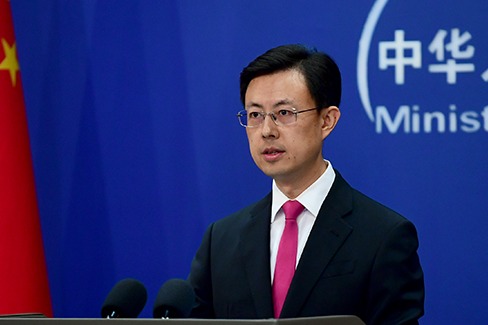Connectivity at core of partnership with ASEAN


Southeast Asia, represented by the 10-member bloc of Association of Southeast Asian Nations, has been the top trading partner of China since 2020, while the latter has consistently been occupying the top slot of the bloc's trading partners for over 15 years. It is an exemplary model of multilateral partnership fostered under the framework of China's neighborhood diplomacy. The mutual trade in goods continues to grow by leaps and bounds.
Be that as it may, the fast-growing China-ASEAN relations are not sufficient to be underpinned by the economic pillar alone. There is now a pressing need to strengthen people-to-people connectivity, which is critical in the implementation of the Belt and Road Initiative. This is particularly so in light of incessant attempts by external powers to stoke instability in the region.
While we have every reason to celebrate the progress of the China-ASEAN comprehensive strategic partnership, it is equally relevant and crucial to scrutinize a few areas of concern that warrant our attention and urgency to address.
People first
As more Chinese supply chains are moving ashore to Southeast Asia in the wake of post-COVID-19 recovery, more varieties of affordable Chinese merchandise are now flooding the ASEAN markets. The growing trade surplus in favor of China has thus been garnering much attention. Trade deficits of ASEAN member states should be given prompt attention before the imbalance is exploited by detractors and populists alike, in pursuit of their respective agenda. No way should it be dismissed nonchalantly as the trade momentum is still going strong.
At the same time, the sporadic echoing of the West's "overcapacity" claims is worth monitoring. Though the demand for "anti-dumping" tariffs against specific Chinese merchandise, allegedly stemming from the overcapacity claim, might be too far-fetched to derail the enduring ties, the blows aimed at the China-ASEAN partnership should never be glossed over. It may signify a new wave of destabilizing moves intended to chip the foundation of the solid China-ASEAN partnership.
After a decade of BRI implementation, China and respective host countries in Southeast Asia should by now be more astute in addressing communication concerns. Clear and distinct definitions should be attached to projects and programs earmarked under the BRI framework. Abuse of the BRI status must be stopped to prevent any confusion from arising, particularly when certain failed projects undertaken by private entrepreneurs may risk tarnishing the credibility of BRI.
Parallel to this, China's State-owned enterprises undertaking the BRI projects alongside the local partners of host countries should be more proactive in playing their ambassadorial roles by reaching out to the local community.
Public communication via proactive community outreach is absolutely crucial for the Chinese SOEs. After all, BRI projects and programs are meant to endear China to the host countries, particularly the public.
This serves as a useful tool to promote "Track 2 Diplomacy" — a type of informal diplomacy that involves nongovernmental, unofficial, and informal interactions — from the macro perspective, in addition to facilitating the progress of the projects on the ground with community support.
The rollout of corporate social responsibility programs, such as hosting of local festive celebrations and charity-centric handouts to the underprivileged by the Chinese SOEs means a great deal to the local community. The thoughtfulness of caring and sharing will certainly bolster people-to-people relations, thereby enriching the success stories of BRI.
The goodwill sown will ultimately pay off as it contributes to the building of positive perception of China in the host countries. In the multiparty electoral endeavors of Southeast Asia, projects or programs that have the people's support can hardly be exploited for adverse publicity during electioneering. On the contrary, any controversy or misgivings arising from the projects will certainly provide ideal fodder for electoral spin doctors.
Plainly put, when BRI projects become people-friendly in the local social fabric, candidates of the contending parties would be left with no choice but to go along with the majority views in advocating the projects.
Over the years, many BRI projects across the world have witnessed flip-flop changes in the stance of host countries following the electoral changes-of-guard. This constitutes a cyclical political risk that China has to navigate in countries practicing multiparty parliamentary election. The best bet in navigating the risk obviously lies in the people at large.
This dimension is no less significant vis-a-vis the present emphasis on people-to-people connectivity through promoting both inbound and outbound tourism and mutual visits of officials between China and ASEAN countries. All these constitute the building of the China-ASEAN community with a shared future.
Key pillars
To usher in an era of a shared future for China and ASEAN, both parties have their mutual interests intertwined. Certainly, it is way beyond a ceremonious joint declaration by the state actors. Substantive milestones marking the escalation of China-ASEAN collaboration from the status of comprehensive strategic partnership to one of a community with a shared future are needed to testify the trajectory.
In this context, China's proactiveness in leveraging the three key pillars of the ASEAN community, underscored in the ASEAN Community Vision 2025 and beyond, is well poised to catalyze the realization of the China-ASEAN community with a shared future. The three pillars of the vision, namely the ASEAN Political-Security Community, ASEAN Economic Community and ASEAN Socio-Cultural Community provide conducive platforms for China to foster more initiatives for China-ASEAN collaboration via the three global initiatives.
Alongside this, existing frameworks such as the ASEAN Defense Ministers' Meeting-Plus and the ASEAN Regional Forum provide additional windows of opportunity for China to strengthen security dialogues and cooperation with the region.
While traditional security collaboration may remain sensitive amid the rising geopolitical competition between China and the United States, collaboration in nontraditional security domains — including law enforcement security, emergency management, public health, food security, energy security and cybersecurity — could perhaps provide a viable alternative for deepening the partnership.
In short, the China-ASEAN partnership is not short of collaborative initiatives at the inter-nations level. The real challenge lies in the synchronization and coordination between the officials at the working level.
By the same token, new flagship initiatives under the BRI framework, such as the China-ASEAN Institute of Modern Craftsmanship and the "Plan of Training for 10,000", are well intended for capacity building in vocational skill training in the respective partner countries, although impact of the program delivery rests much on the responsiveness of individual partner countries.
As the China-ASEAN partnership is steadily evolving and progressing with the changing regional dynamics and developmental needs, more new drivers for economic growth and elements for sociocultural engagement are emerging from time to time on the horizon.
Knowing that the endeavor is an arduous task, involving not only the state actors who dominate the "Track 1 Diplomacy", people-to-people connectivity involving the civil bodies across the individual ASEAN countries is therefore absolutely relevant and should be factored into the equation.
The author is president of the Belt and Road Initiative Caucus for Asia Pacific.

































